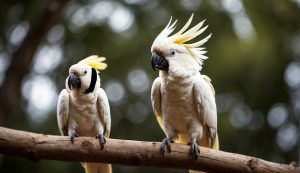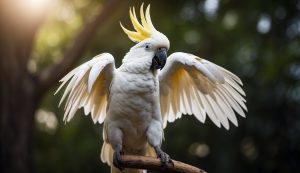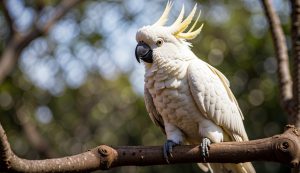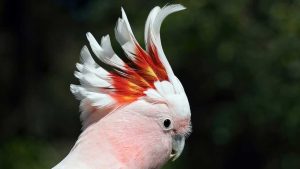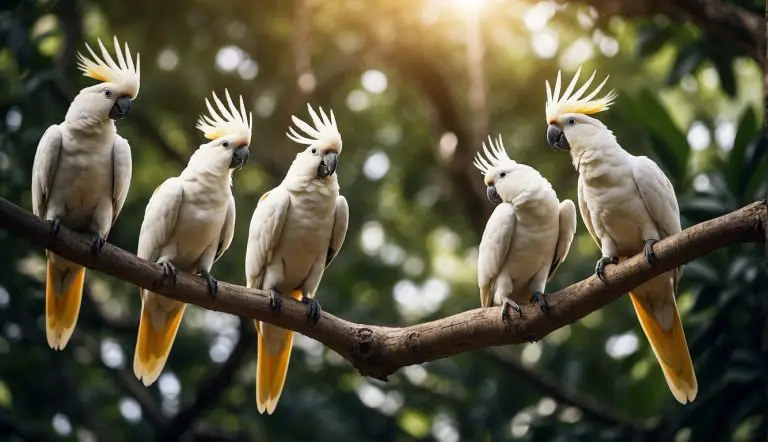How to Calm a Cockatoo: Effective Techniques for Soothing Your Bird

Cockatoos are known for their sociable and affectionate nature, making them beloved pets for those who have the time and resources to dedicate to their care. Like any pet, cockatoos experience a range of emotions, including stress and anxiety, which can lead to behavioral issues if not properly managed.
Understanding how to calm a cockatoo is essential for ensuring a harmonious relationship between the bird and its owner.
Achieving a state of calmness in cockatoos involves recognizing their complex emotional states and responding appropriately to their needs for comfort and security.
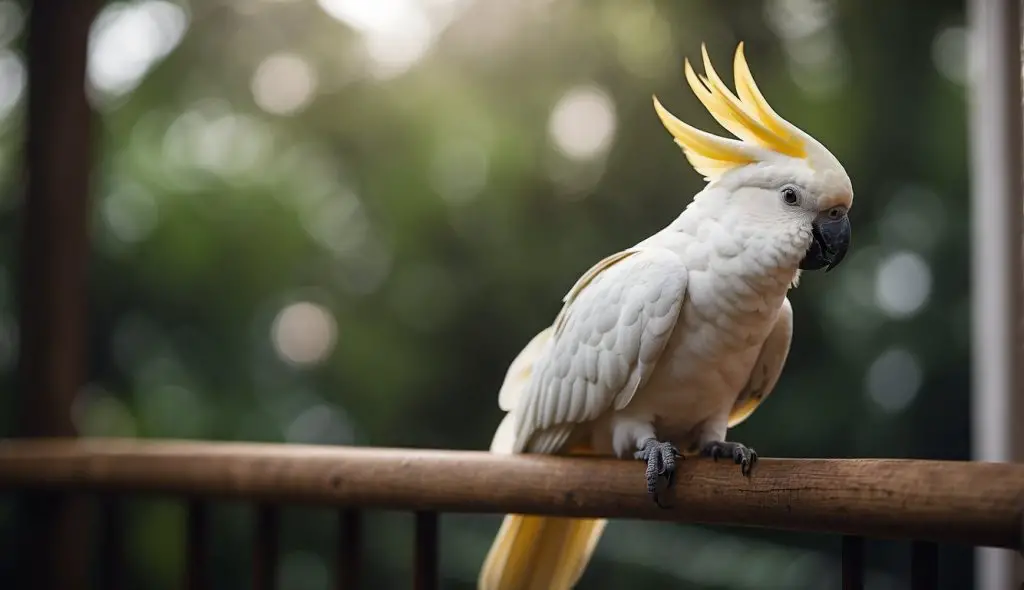
Creating a conducive environment is key to keeping a cockatoo calm. This involves more than just providing a cage; it includes giving attention to the bird’s mental and physical stimulation needs.
My experience with cockatoos has taught me that these intelligent creatures require a routine they can rely on, a selection of toys for mental engagement, and gentle interaction with their human companions.
Bonding with a cockatoo means engaging in regular, positive training sessions that build trust and provide a sense of accomplishment for the bird.
Coupled with proper daily care, including a balanced diet and clean living space, a cockatoo can feel at ease and display a content and happy demeanor in its home.
Key Takeaways
- Recognizing and responding to a cockatoo’s emotional states promotes calmness.
- A stimulating environment and consistent routine contribute to a cockatoo’s feeling of security.
- Positive interaction and regular care are crucial for a cockatoo’s well-being.
Understanding Cockatoo Behavior
When caring for cockatoos, it’s crucial to recognize their complex behaviors and needs. These intelligent birds require attention, socialization, and proper care to remain calm and happy.
Communication and Vocalizations
I’ve learned that cockatoos communicate through a variety of vocalizations, from soft chatters to loud screams.
Frequent vocalizations are often a plea for attention or a sign of excitement.
To discourage excessive noise, I try to respond to quiet sounds and ignore screaming, which teaches my cockatoo that not all vocalizations get my attention.
Socialization and Interaction
Cockatoos possess a social nature akin to humans, desiring interaction with their flock or family, which includes people.
Bonding with my cockatoo involves regular, gentle handling and spending quality time together. Failing to do so can lead to boredom and stress.
Signs of Stress and Anxiety
Recognizing stress in cockatoos is vital for their well-being. Stress triggers I’ve noticed include changes in the environment or routine, fear, and aggression from unmet needs.
Aggressive behavior or feather plucking are clear signs my cockatoo may be stressed.
Encouraging Positive Behavior
I use positive reinforcement and rewards for encouraging desirable behavior in my cockatoo.
Consistent training sessions, where I teach simple tricks or engage in clicker training, provide mental stimulation and strengthen our bond.
Nutrition and Well-being
Proper nutrition greatly impacts a cockatoo’s energy and mood.
I make sure my cockatoo’s diet includes a mix of seeds, pellets, nuts, fruits, and vegetables to keep it balanced. A fresh supply of water is always available to maintain hydration.
Physical Activity and Stimulation
Cockatoos need ample energy outlets.
Exercise, playtime, and entertainment through puzzle toys or foraging activities help my bird stay engaged.
Ensuring the cage has space for movement and different types of perches encourages physical activity.
Rest and Comfort
Adequate rest is crucial for my cockatoo.
I set up a quiet corner in the home with a soft perch away from noise for comfort. Exposure to natural light during the day and a consistent night routine help keep my bird’s diurnal cycle on track.
Cockatoo Health Concerns
I keep a close eye on my cockatoo’s health, as behavior changes might signal medical issues.
Regular veterinary check-ups ensure any health concerns are addressed promptly, ensuring my cockatoo stays content and at ease.
Creating a Cockatoo-Friendly Environment
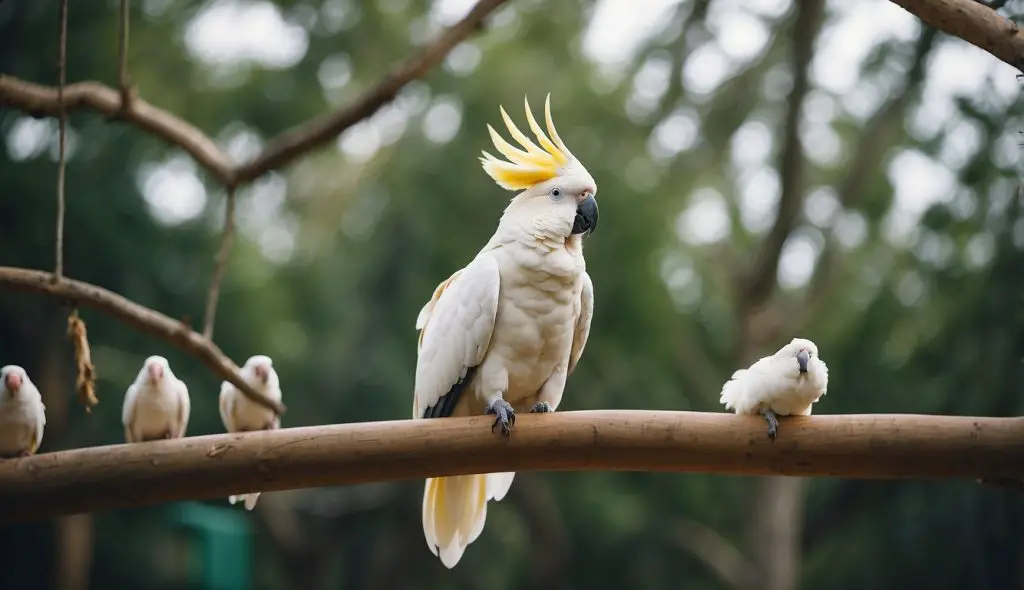
Ensuring a cockatoo’s happiness involves more than just providing food and water; it’s crucial to create a supportive home environment that caters to their complex behavioral needs.
Setting Up the Home Environment
My focus is on replicating a natural habitat within my home to promote a sense of security for my cockatoo.
This begins with the proper positioning of the cage in a well-lit area where natural light is abundant but out of direct sunlight which could cause overheating.
I make sure the cage is large enough for them to flap their wings and move freely. I place it in a quiet corner, away from drafts and excessive noise, which can cause stress.
Toys and Entertainment
Cockatoos are intelligent and inquisitive, so I ensure they have various toys to interact with.
Foraging toys that hide treats are fantastic — they encourage natural scavenging behavior. Simple toys like balls, and even mirrors, can be incredibly entertaining for them. I rotate the toys regularly to keep their environment stimulating and engaging.
The Role of Regular Routines
A consistent routine is essential.
I establish and maintain a regular schedule for feeding, playtime, and rest. Regular interaction is not just appreciated but necessary due to their social nature.
This consistent routine helps my cockatoo know what to expect throughout the day, which reduces anxiety.
Managing Noise and Surroundings
Cockatoos can be sensitive to noise.
I strive to keep the environment around my bird as quiet as possible, minimizing loud noises that may startle them, like blaring music or the television. A peaceful environment helps prevent behavioral problems that stem from stress and fear.
Introducing New Family Members
When introducing new pets, like a cat or another parrot, I do it gradually.
Cockatoos are social birds, but caution is key to ensure they’re comfortable with newcomers. I supervise all interactions to prevent unintentional harm and to build positive relationships among my feathered and furry family members.
Safety and Space
My cockatoo’s safety is paramount.
I ensure there’s enough space for their wingspan in the cage and in the home. Open windows, fans, and cooking appliances are hazardous, so I keep my bird safely away from these areas. Their space is their sanctuary, and it’s my job to make it as secure as possible.
Training Your Cockatoo
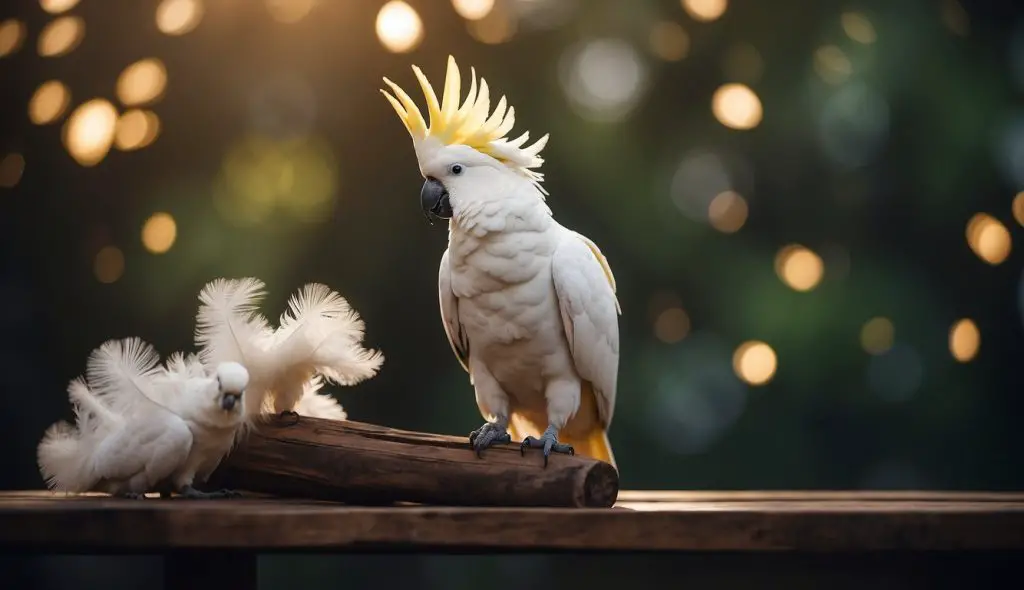
When I train my cockatoo, I focus on building our bond, ensuring I use positive reinforcement, and managing their vocal tendencies with patience and care.
Basic Commands and Tricks
Teaching my cockatoo basic commands and tricks is a rewarding way to engage their intelligence and satisfy their need for attention.
I start with simple commands like “step up” where they learn to step onto my hand or a perch on command. My routine includes tricks like turning in a circle or waving, which are not only entertaining but also enhance our interaction.
Developing a Bond Through Play
Playtime is pivotal in cementing the bond between me and my cockatoo.
During play, I introduce games like fetch or chase, which allows us to share moments of joy. This interaction through play doesn’t just keep them entertained but also contributes to a calmer demeanor.
Use of Positive Reinforcement
I always use positive reinforcement to promote good behavior in my bird.
This means offering immediate rewards such as treats or verbal praise when they follow a command or behave desirably. The key is consistency and patience, making sure to reinforce good behavior every time.
Addressing Screaming and Loud Behavior
Cockatoos can be quite loud, and I address screaming or loud behavior by identifying triggers and providing distractions.
Strategies like teaching a quiet command or a soft, reassuring phrase help. It’s essential to avoid negative reinforcement, which can exacerbate the behavior.
Expert Advice and Professional Help
Lastly, I sometimes seek expert advice or professional help, particularly when behavioral issues persist.
A knowledgeable veterinarian or an avian behaviorist can provide invaluable guidance in tailoring a training approach suited to my cockatoo’s unique needs.
Daily Cockatoo Care
In my experience with cockatoos, consistent daily care is crucial for their well-being, encompassing a balanced diet, mental and physical stimulation, and regular social interaction. https://www.youtube.com/embed/vJG62OtQePw
Feeding and Nutrition
I always ensure my cockatoo accesses fresh water daily and provide a varied diet that includes a mix of pellets, fruits, and vegetables.
A balanced nutritional plan like this supports their health and mirrors their wild diet, preventing obesity and related health issues.
- Fruits and Vegetables: I offer a variety of chopped vegetables and fruits to make meals more enticing.
- Pellets: These should be high-quality and formulated specifically for cockatoos to guarantee all nutritional needs are met.
- Water: Fresh, clean water available at all times is vital for hydration and overall health.
Keeping Your Cockatoo Active
Cockatoos are intelligent and need daily exercise to stay healthy. I find the following activities helpful:
- Flying: Safe, supervised flying time in a secure area allows them to stretch their wings.
- Walking: A harness-trained cockatoo can join me for a walk, which is excellent for stimulation.
- Playtime: Engaging toys and puzzles can provide necessary mental and physical exercise.
Social Interaction and Mental Health
Cockatoos require socialization due to their social nature. Spending time talking, playing, or simply being in the same room helps them feel connected and prevents behavioral problems.
- Attention: A dedicated interaction time each day helps to strengthen our bond.
- Mental Stimulation: Cockatoos are intelligent birds. They crave and enjoy learning new tricks or commands, enhancing their mental health.
Grooming and Touch
Grooming is more than just upkeep—it’s an opportunity for bonding and checking on my cockatoo’s health. Here’s what I include:
- Touch: Regular, gentle handling helps maintain our bond. It also allows me to check for any abnormalities in their feathers or skin.
- Bathing: I offer a shallow dish of water for self-bathing. I also gently mist my cockatoo, encouraging natural grooming behaviors.
Routine Health Checkups
Just like humans, cockatoos benefit immensely from regular health checkups. I schedule visits to the veterinarian for routine exams to ensure their physical health is monitored and maintained.
- Veterinarian Visits: Annual or semi-annual checkups can help spot health issues early.
- Emergencies: Knowing the signs of distress or illness allows me to act swiftly should my cockatoo need immediate care.
Frequently Asked Questions
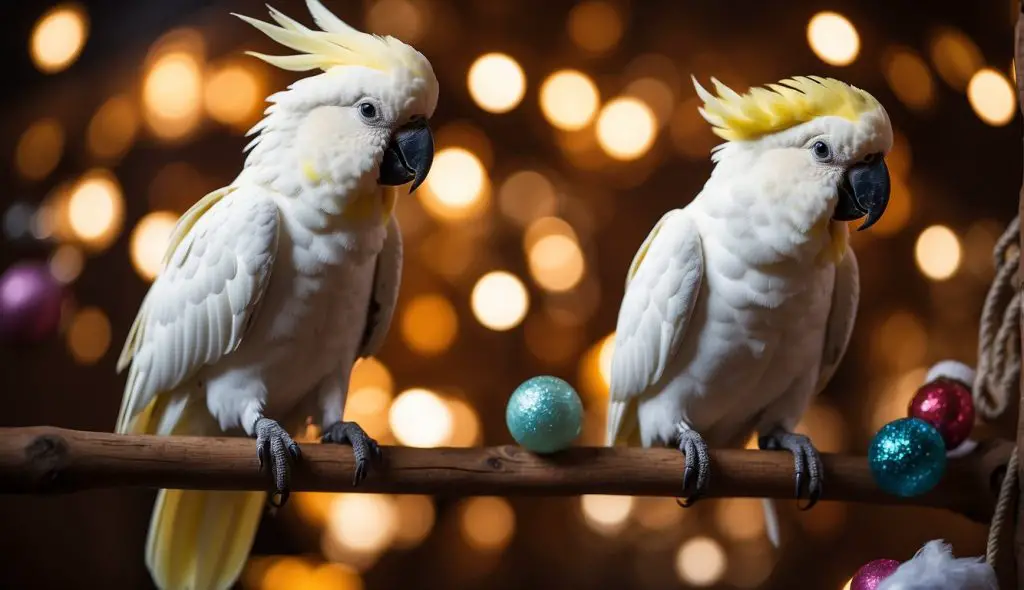
In this section, I’ll address some common inquiries about calming a cockatoo. Whether it’s bedtime or a stressful situation, I hope my insights will help bird owners find effective solutions.
What are effective techniques to soothe a cockatoo during bedtime?
To soothe a cockatoo at bedtime, I make sure to establish a quiet and dark environment. A routine of gentle speaking or playing soft music can signal that it’s time to rest. Covering the cage with a breathable cloth can also create a calming atmosphere for sleep.
Can a change in environment help to settle a cockatoo at night?
Yes, a change in environment can help settle a cockatoo at night. I’ve found that reducing noise levels and dimming lights can significantly calm a cockatoo. Ensuring the bird’s sleeping area is away from disturbances contributes to a more peaceful night.
Are there safe calming medications or supplements for cockatoos?
When considering medications or supplements to calm a cockatoo, I always consult with a veterinarian first. While some products may be advertised as safe, professional guidance is crucial to prevent any harm to the bird’s health.
What methods can be used to calm a cockatoo experiencing shock?
When a cockatoo is in shock, I approach it calmly and speak in a soothing manner. Creating a warm environment and offering a safe space, like a covered cage, can help. I avoid sudden movements to prevent additional stress.
How should one approach and calm an injured cockatoo?
Approaching an injured cockatoo requires extreme care. I speak softly to maintain calmness and avoid quick movements that might startle the bird. I also make sure it is comfortably restrained before a veterinary professional can evaluate its injuries.
What actions should be avoided when trying to relax a cockatoo?
When trying to relax a cockatoo, I never shout or make abrupt movements. These can increase their anxiety.
I avoid forcing interaction. Instead, I allow the bird to come to me when it feels comfortable, reducing potential stress.


